26-27 September 2022

Tashkent is a city of very modern buildings interspersed with some ugly Soviet relics, green manicured parks, fountains, and a very organized traffic system. Except for closing down the streets and having armed guards every 100 feet, severe restrictions as to where you can take a picture without being shot, all in the “protection” of their president, Tashkent is really a beautiful walking city. They even have an artsy metro in the vein of the famous Soviet metro.
Cameras, and heavily armed guards, are everywhere. So is the flashy Hyatt Regency, a high rise Ramada Inn though our guide says “remodeled by Ramada but smells like Soviets,” trendy shopping like Armani and Apple, kiosks to buy a chizburger or Gamburger, and one of the best traffic systems I’ve experienced. Every light is timed and pedestrians obey them.
This busy capital city of Uzbekistan boasts of more than 2,200 years of written history and of almost 2.5 million people. Settled since the 5th century BC, locals know it as “Tash” – A Rock. It is a cosmopolitan, active and colorful city thanks to the colored lights throughout the city and boulevards. Every night looks a little like Christmas.
Time is spent at the State Museum of Applied Arts. The beautifully tiled building houses a large collection of Uzbek embroideries, textiles, woodwork, hats, and Uzbek and Russian clothing. The collections of ceramic and artwork are interesting. The building was the former home of an Imperial Russian diplomat and his mansion is decorated in traditional Uzbek style and quite nice.
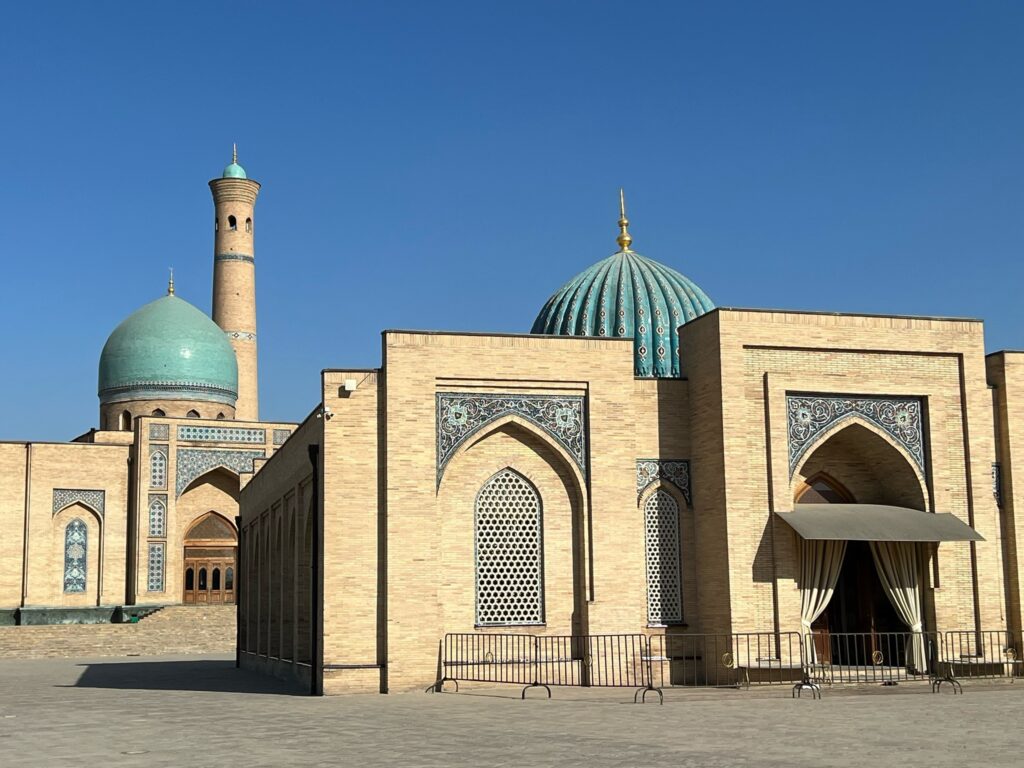
The Hazarti Iman square is the spiritual heart of Tashkent and tan exceptional collection of the beautiful turquoise domes and architecture of the Timurid Empire. (In Tashkent, I am constantly reminded that it pales in significance when compared to Samarqand.) The complex of astounding buildings and gardens include several mosques and Madrassas (schools). The huge square is bordered on three sides by the Ulugh Beg Madrassa (1421), Tilla Kari Madrassa (1660) and the Shir Dor Madrassa, the one with the tigers (1636). The latter two were built by the governor of Samarkand, Bagadur. In the center of the square is the smaller Muyï Mubarak Madrassa which acts as an important library/museum. Here one of the most precious copies of the Koran is housed, dating back to the rule of Khalif Usman who ordered the writing of the first Koran. The book is among one of the 5 first Koran books ever created.
Nearby is the Kaffal Shashi Mausoleum. Abu Bakr Mohammad Kaffol Shoshiy (904-977) was a leading Sunni scholar and poet. He was born in Tashkent. Kaffal Shashi became an Islamic saint after his death in 976, his grave becoming a place of pilgrimage. In the 16th century a mausoleum was built over the grave, and the cemetery and area around it was named Khazrati Imam.
Morning finds me strolling modern Tashkent and its beautiful gardens. A short walk from my hotel and crammed into a green space more than 1.3 miles end to end, are many modern Uzbek government buildings, the National Security offices, library, children’s center, opera, monuments, museums and more (think Washington DC’s Mall). It is a wonderful place to spend many hours exploring. But a word of warning – here are the offices of the President who is very camera shy. No photos are allowed in his direction, even of his gardens or his trees. Each morning he is driven to his office and streets are shut down, police stand every 100 feet or so, and NO PHOTOS!
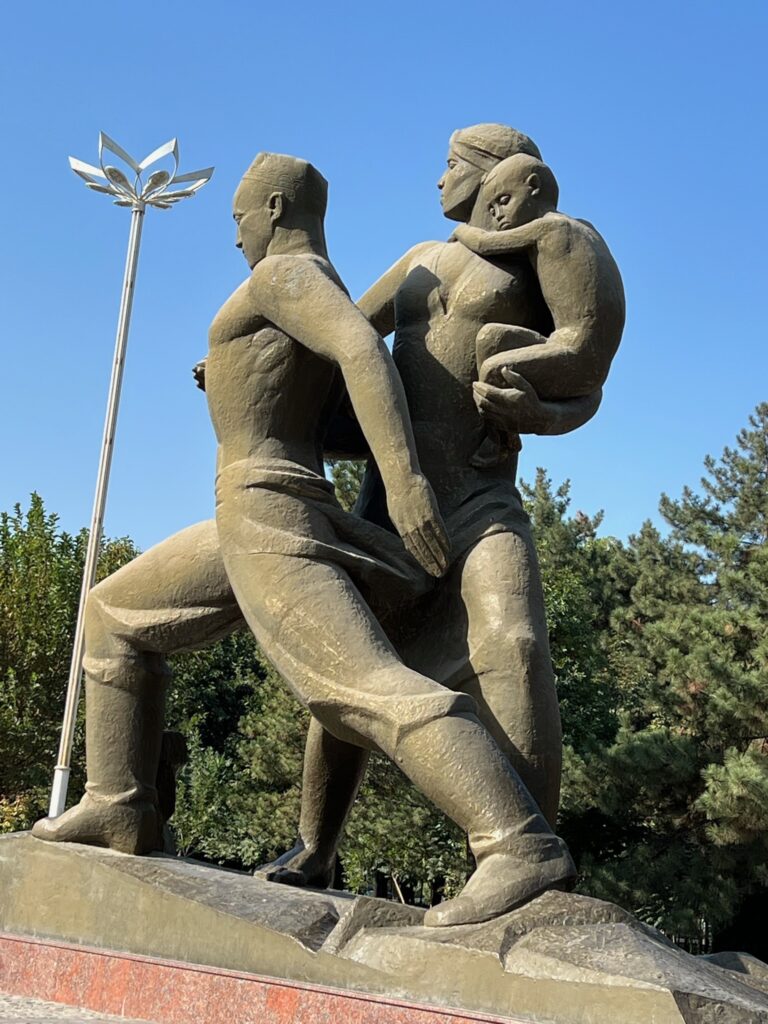
We begin our walk at Monument of Courage Square. The first thing that attracts the eye is the massive Soviet monument, the second thing is how clean everything is. The square is centered between old and new Tashkent. On 26 April 1966, at 5:22:49, this was the epicenter of a 5.2 earthquake. The earthquake caused massive destruction to Tashkent, destroying most of the buildings in the city, killing between 10 and 200 people and leaving between 200,000 to 300,000 homeless (depending on whose numbers you accept). Following the disaster, most of the historic parts of Tashkent had been destroyed and the city was rebuilt, modelled on Soviet architectural styles.
Like any prosperous western city with shops ranging from an Apple reseller to Sketchers, the wide boulevards are busy. Roads are good and at least 4 lanes wide throughout the city. And traffic, at least 50 of 51 cars being white, is heavy. What looks like chaos with no driving rules is deceiving. Cars and buses, no matter how large and where in the street, make u-turns whenever the desire comes upon them. People know when it is their turn, pedestrians are given right of way, and I note few dents so there must be an artful dance to driving in Tashkent. There are also Tourist and Traffic Police everywhere.
We stop in Mustakillik Maydoni/Independence Square, the largest in the city. Previously “Lenin Square,” after Uzbekistan’s proclamation of independence in September 1991, the large square was renamed. Lenin’s monument was replaced with the Monument to Independence. The monument is topped by a globe with a bronze female and child representing the Motherland. The square is host to many celebrations and military parades; the globe is off limits as it is too close to the President’s office. Uzbeks want to protect him as presidents are a rare earth element here; Mirziyoyev is only the second president to hold office in the last 30 years.
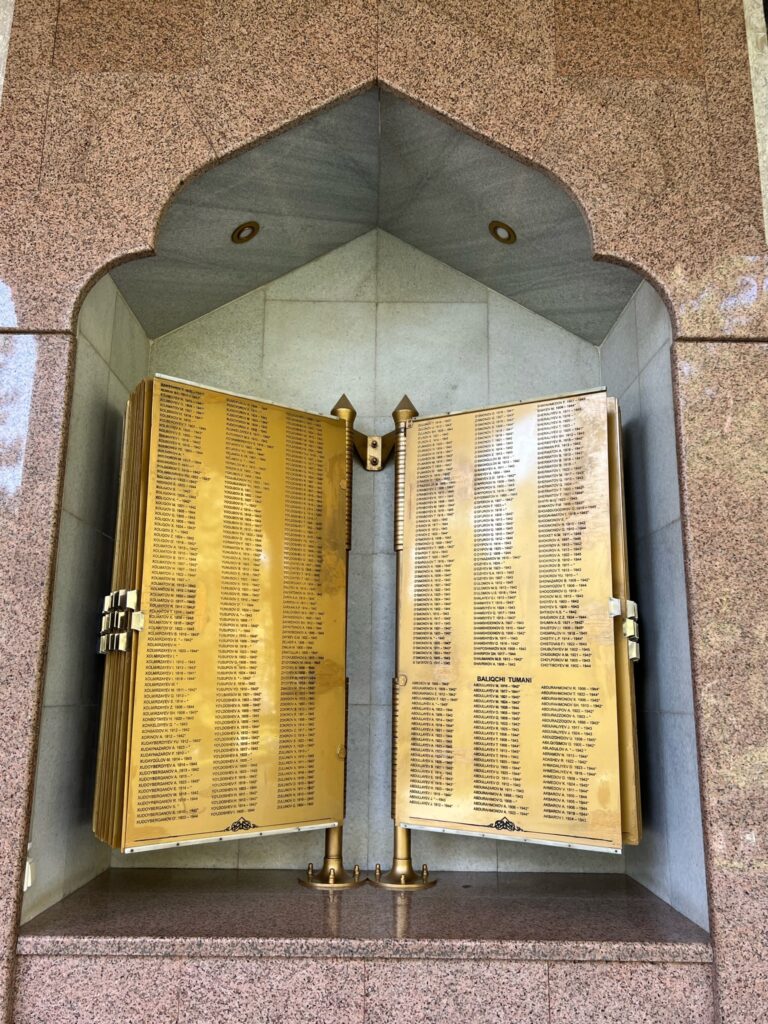
Near the square is the eternal flame which recognizes those who fought in WW2, the Arch of Ezgulik to Humanism with its graceful sculpture of silver storks, and the Tomb of the Unknown Soldier dedicated to the Soviet soldiers of WW2. Under beautifully carved pergolas, several large brass books are engraved with the names of 400,000 Uzbek soldiers who died in that war. Monuments and fountains abound. Though the square has been a center point since 1865, the surround buildings are more modern in architecture. And there are areas off-limits for photos and police to make sure you don’t point your camera in the wrong direction.
Brodvey is Tashkent’s answer to Broadway – lively and colorful. It is one of the oldest and best walking places in the city and filled with artists, cafes, and great ice cream and coffee. Brodvey is the place to stroll, meet friends and socialize. It is essentially a large space between Independence Square and Amir Temur Square.
A short walk east of the square is the Alisher Novoi State Academic Bolshoi Theater which is a mix of Uzbek/Russian architecture. Amateur lovers of the arts founded a professional theater in 1939. In 1942 the building of the theater was begun and opened on the 500th birthday anniversary of Novoi, a Turkic poet and writer, politician and mystic born in Afghanistan. He was the recognized leader in Chagatai which is the ancient and extinct Turkic language spoken throughout Central Asia. Unfortunately, Uzbeks are not big opera buffs and few performances are staged at the theater.
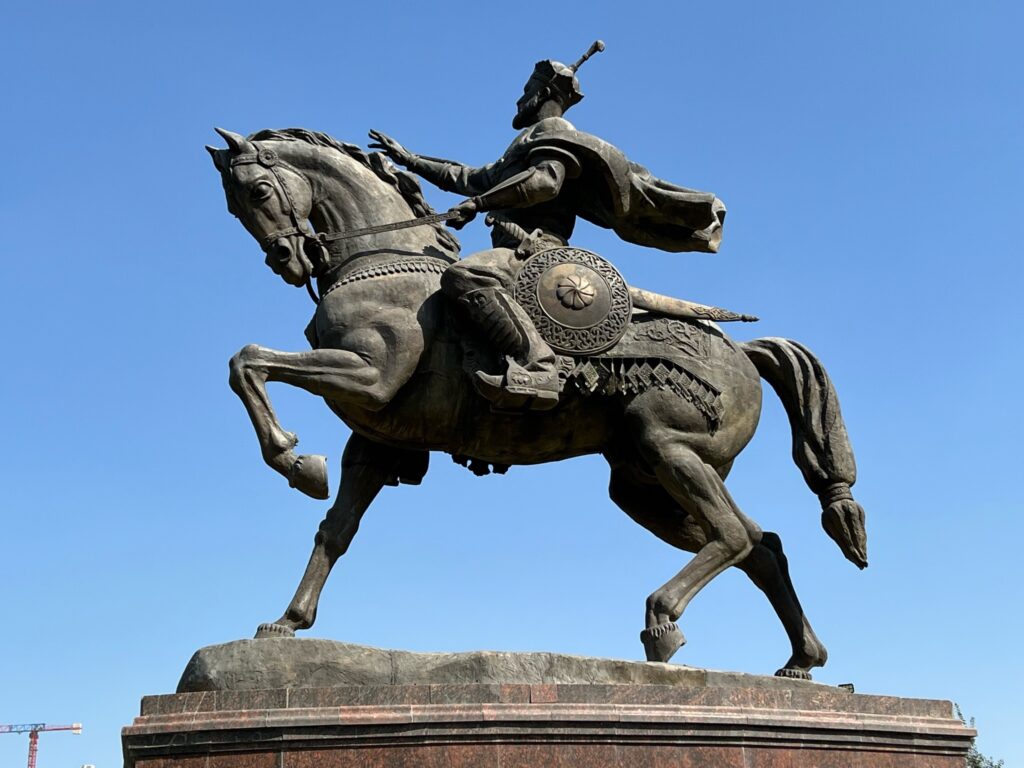
Amir Temur Square contains several attractive 20th century buildings and a rather ugly Uzbekistan Hotel. However, it also includes Amir Temur Museum and a wonderful bronze equestrian statue of Amir Temur. Temur is the Mongol warlord known to me as Tamerlane. Newlywed couples of every city seem to have a special place for photos. In Tashkent, it is the statue of local hero Temur.
Temur was a Persian who founded the Timurid Empire of Iran and Central Asia and ruled for over 30 years. He saw himself as the heir of Genghis Khan, hoping to restore the Mongol Empire. From his base in Transoxiana/Uzbekistan, he waged military campaigns across Central Asia, the Caucasus and southern Russia. Temur is recognized as one of the greatest military leaders and tacticians in history. He defeated armies as far and wide as Delhi, the Levant, Armenia and across Anatolia, losing to the Ming Dynasty only because he died enroute. Amir Temur promoted science, education, culture, architecture, the fine arts, music and poetry. Ultimately, he became the most powerful, and ruthless, ruler in the Muslim world and established what is known as the Timurid Renaissance. Though his empire fell apart after his death in 1408, his influence on this part of the world cannot be underestimated.
Temur’s home base was Samarqand where there is much more to see. We did learn where we got the name Tamerlane. Temur suffered a leg injury and walked with a limp. “Lane” means limp so he was known by many as Limping Temur, but I am sure not to his face. I also hope he doesn’t hold me to an accurate spelling of his name. It is seen as Timur and Temur. The Uzbeks have Temur on their statue so I am using that spelling.
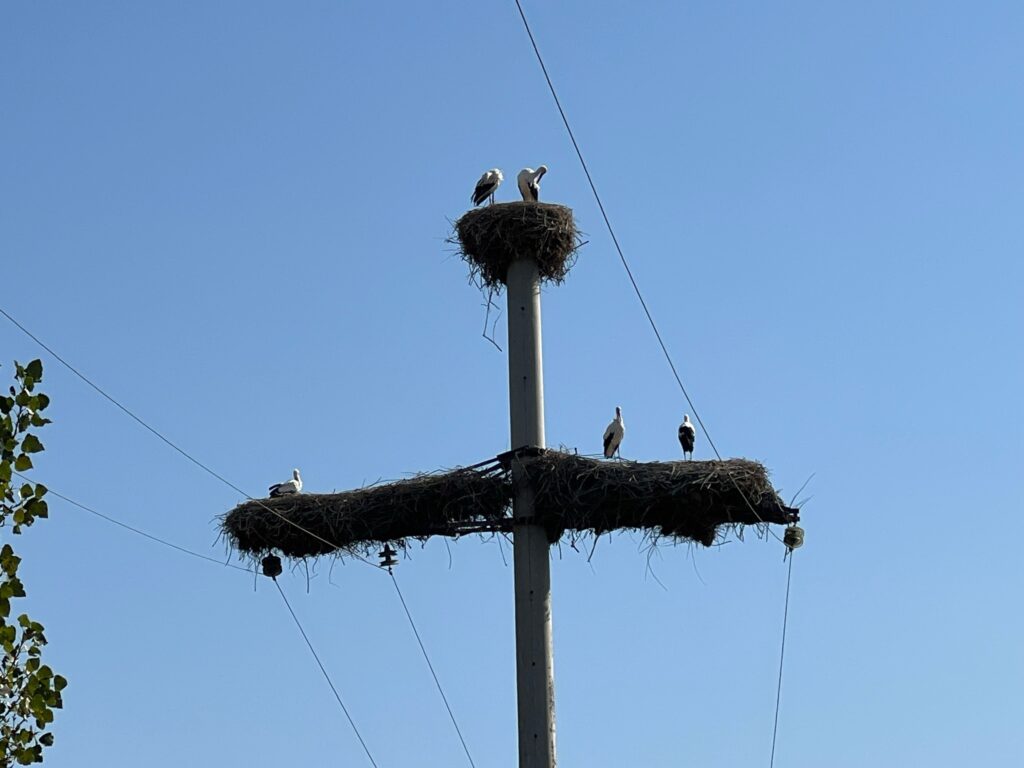
It continues to be hot, above 90°, and a reprieve from the sun is appreciated. We dine in a local restaurant which is a very large room with lots of seating. The food is good and plentiful, the beer sparse. Too bad as I need to fortify myself for the long 200-mile, five-hour ride to Samarqand.
Our drive is highlighted by a road imitating a “sea of waves” interspersed with pot holes, wonderful stork nests built on the roadside towers, and lots more brown dirt. I am told the temperature will drop by 10 degrees. As we approach Samarqand, brown transmutes to green and several roadside businesses are selling large evergreen trees for planting. All encouraging signs of a cooler, greener environment.
Five Stans became Four – Eight now is Six.
This is a tough trip made worse by the heat and terrible air quality. One member of our group remained in Tashkent. They are unable to fly home under the worst unplanned circumstances: Hurricane Ian is heading for their home in Florida and fleeing Russian men are filling the airplanes. However, even though there are sniffles and coughs, there is no Covid.
0 Comments